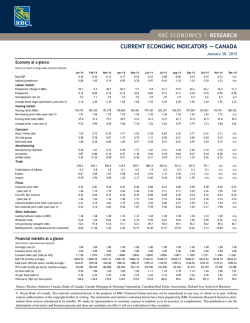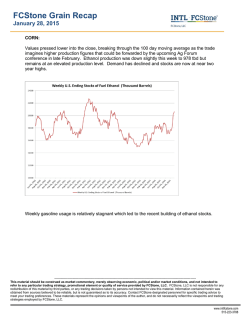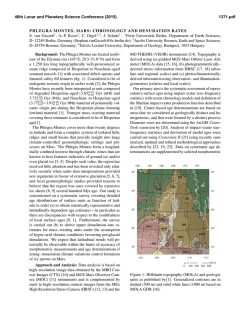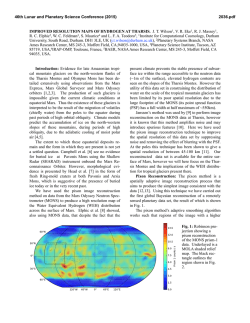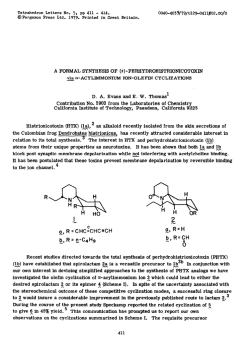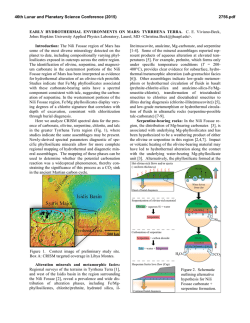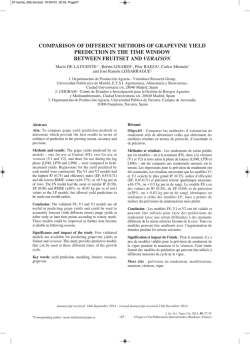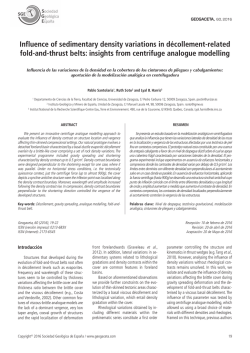
Lessons learned from south american intensive management
Role of intensive management, Technology and Tree Improvement in Chilean Productivity: Applicable Operational Lessons for SE US Growers Cristian R. Montes, PhD Warnell School of Forestry and Natural Resources University of Georgia Summary • Context • Spatially explicit environmental information used at every step of the process • Matching carbohydrate reserves with site environmental information helped clonal program success. • Clonal Program success largely dependent on Nursery deployment program. • Site biophysical information is used to determine growth constrains and plant limiting factors • Growth and yield models are combined with environmental information to make better decisions Forest objectives •5.8 million acres intensive forest •3 species mainly clonal: P.radiata (60%), E.globulus (70%), E.nitens (3%) Large Variability in Temperature and rainfall in Chile, therefor, other information is needed. Mean Yearly Temperature Mean Yearly Rainfall (°C) (mm) -3.7 - 5.5 377 - 900 5.5 - 7.6 900 - 1,300 7.6 - 9.4 1,300 - 1,600 9.4 - 11.1 1,600 - 1,900 11.1 - 12.7 12.7 - 15.5 48° – 59° F range 1,900 - 2,200 2,200 - 3,827 15 – 100 in range Water holding capacity is being estimated using pedotransfer functions 0 100 } 10 20 } 80 30 70 40 60 50 50 60 40 Moist Content % 40 30 30 20 20 10 10 0 70 80 } 90 100 0 10 90 Soil Water Storage Capacity 0 20 30 40 50 60 70 80 90 100 % Sand 2 – 10 inch range Site specific Silviculture works at the zone scale. Precision silviculture uses spatially explicit information to make recommendations We wanted to estimate likely forest in between our estimates, and predict silviculture response Extra information is used to interpolate 23 16 11 15 10 16 20 17 28 21 21 24 20 22 Extra information is used to interpolate (that includes some noise) 23±5 16±2 11±1 15 10±.5 16±2 20±4 17±4 28±2 21±2 21±4 20±5 24 22±2 Containerized rooted cuttings Clones out of somatic embriogenesis Expected 15% gain at rotation age Containerized rooted cuttings in Eucalyptus No need for somatic embriogenesis Expected 40% gain at rotation age Result from the process Bare root cutting. Containerized Cutting: Two major limitation to clonal production out of somatic embryogenesis: Making the trees to grow roots Radiation Intensity and light quality research important to better understand Clonal production variables. Rooting Probability Light intensity affects clonal chances to root Light Intensity (mmol m2 s-1) Application of artificial light in greenhouse duplicate plan growth rate No light Light Gaining better light-water-nutrient understanding through detail environmental measurements and modeling. 2nd Peek growth rate 1st Peek grow rate Initial lag 1st Rooting Plateau “Lettuce plant” High glucose concentration High chlorophyll Fast initial grow Doesn’t resistant drought “Potato” plants Drought resistant High starch concentration Low initial grow Taste bad if put in the refrigerator Concept utilized to predict field performance: Grow • On a sunny day, 1g fixed CH2O, investing in 2 g of biomass or in storage. Stay alive (respiration) • One seedling would use up to .5 gr C at 77°F through respiration • At 95° F it will use up to 1 g de CH2O. (Q10) Compaction did not affect survival, drainage did. Flooded site = 20 times more respiration compared to unflooded plant. At 41° will use 0,2 gr, Flooded will use 4g, For a 0,5g during winter fixation Draining excess moisture or bedding better than subsoiling in some sites Flow Direction and Flow Accumulation Used to better design drainage chanels 0.93 (m3/s) Two chanels 0.4 x 0.4 meters Dry soils with low hydraulic conductivity, higher frost damage probability. T° Dying plants because of excess temperature not because of rainfall. T° High weed, high frost effect. No weeds, no High weed, high frost mortality Predio Nicaragua Big impact of harvesting machinery In soil compaction and internal drainage Stand Yield for several establishment treatments, showed varying levels of responsiveness Volume yield (m3/ha) Treatments: Full Weed C. Sub Soil + Weed None Age (years) Response for subsoiling at 5 years of age Bulk, density Clay content (%) 62 0.2 - 0.9 0.9- 1.1 1.1 - 1.3 1.3 - 1.5 0 %Organic Matter 0-3 3-6 6-9 9 - 12 12 - 25 Water deficit(mm) High : 0 Low : -1276 1.5 - 2.6 Relative Response at 5 years No Subsoiling 0 – 50% 50 – 200% 200 – 500% Barria and Montes 20 Precip. PET 300 Water (mm) 250 200 150 100 50 JA N FE B M AR AP R M AY JU N SE P O C T N O V D EC JU L AU G 0 Month 300 Water Deficit -1,276- -940 -940 - -750 -749 - -550 250 Water (mm) (mm) Precip. PET 200 150 100 -549 - -300 -299 - -150 50 Month JU N AY M AP R AR M FE B JA N V EC D O C T N O SE P AU G JU L -149 - 0 Good agreement between WDI and yield in Chile First Year Survival (%) Water Deficit Index (mm) Water Deficit Class (mm) Spot No Control No Control No Weeds No Weeds No Water Deficit Strong Water deficit More trees per hectare = more yield Crecimiento Corriente en Volumen (m3/ha/año) entre los 5 y 5 6 años los ensayos de espaciamiento Volume growth between andpara 6 years 60 Volume growth (m3/ha) 50 40 30 20 Chan Chan Bajo Cuy inco Alto Villa Alegre Grande Las Lumas Hijuela 3 Molino del Sol Pinares de Forel Pichinguileo Huelón San Gregorio Mingre SanGregorio Mingre Rari Quiv olgo 1 Reñico San Luis 2 Collico Guacamapu Water Deficit Index Pr: Pr: Pr: Pr: Pr: Pr: Pr: Pr: Pr: Pr: Pr: Pr: Pr: Pr: Pr: Pr: Pr: ICA VHA (m3/ha) 10 Crecimiento Corrien 0 0 500 1000 1500 2000 Densidad de Plantación (árb/ha) Planting density (trees/ha) 2500 3000 Plantation density to affect more on highly productive sites Crecimiento los 500 árboles dominantes entre los 5 y 65años Volume growth forde500 dominant trees between and 6 years 35 ICA VHA 500 (m3/ha) Water Deficit Index Volume growth (m3/ha) 30 25 20 15 Pr: Pr: Pr: Pr: Pr: Pr: Pr: Pr: Pr: Pr: Pr: Pr: Pr: Pr: Pr: Pr: Pr: Chan Chan Bajo Cuy inco Alto Villa Alegre Grande Las Lumas Hijuela 3 Molino del Sol Pinares de Forel Pichinguileo Huelón San Gregorio Mingre SanGregorio Mingre Rari Quiv olgo 1 Reñico San Luis 2 Collico Guacamapu 10 5 Crecimiento Corrient 0 0 500 1000 1500 2000 Densidad de Plantación (árb/ha) Planting density (trees/ha) 2500 3000 Area Foliar v/s Incremento Volumen Ensayos Poda 26 24 22 20 18 16 14 12 10 8 6 4 2 0 0% 28 27 26 25 24 23 22 21 20 19 18 17 16 15 14 13 12 11 10 9 8 7 6 5 4 3 2 1 0 0.0 Water Deficit (-mm) 3 (m3(m Increment Volume /ha/year) Volume growth (m3/ha) Incremento /ha) Volumen Leaf Area Efficiency varied between Sites, depending on water availability ENS: 501 (El Peral) ENS: 502 (Laguan) ENS: 503 (Los Remolinos) ENS: 504 (Pilpilco A.) ENS: 505 (Santa Estela) ENS: 506 (Pidima) 10% 0.5 1.0 20% 1.5 30% 2.0 40% 2.5 50% 3.0 60% 3.5 LeafLeaf Area LAI_final After Pruning % Area Removed (m2/m2) 70% 4.0 4.5 80% 5.0 The more the density, la bigger theAleaf area up to a fix amount TENDENCIA MAYOR IAF MAYOR DENSIDAD INICIAL 4 CLON KC59 CLON LX876 FAM S1 INDICE DE AR Leaf Area Index (m2/m2) ) 2 /m 2 3 2 1 800 1200 1600 2000 DENSIDAD INICIAL (árb/ha) Initial Density (trees/ha) 2400 Same yield, different canopy sizeCOPA v/s LX876 KC59 MAYOR INCREMENTO A IGUAL LARGO 60 45 /ha/año) 3 Volume growth (m3/ha) CLON: KC59 CLON: LX876 30 15 KC59: ICA_VHA = 16.7769+1.4769*LCopa LX876: ICA_VHA = 6.1915+1.5296*LCopa INCREMEN 0 0 5 10 15 LARGO COPA (km/ha) Canopy length (trees/ha) 20 25 The one with more juvenile leaves was able hold them even at high LARGO COPA JUVENIL KC59 NOtoES AFECTADO PORdensities DENSIDAD LARGO COPA JU Juvenile crown length (m2/m2) 6 5 CLON KC59 CLON LX876 FAM S1 4 3 2 1 0 800 1200 1600 2000 DENSIDAD INICIAL (árb/ha) Initial Density (trees/ha) 2400 Current annual increment (feet3 acre-1 y-1) Light Interception is the driver for Biomass Production R2=0.90 160 140 120 100 80 60 40 20 500 1000 1500 2000 2500 Annual IPAR(MJ m2 y-1) (Adapted, Will et al., 2005) 3000 Digital Terrain Models help evaluate plantations in context of the landscape Slope 0-6 6 - 12 12 - 17 17 - 22 22 - 27 27 - 31 Aspect 31 - 34 34 - 39 Flat (-1) North (0-22.5) Northeast (22.5-67.5) East (67.5-112.5) Southeast (112.5-157.5) South (157.5-202.5) Southwest (202.5-247.5) West (247.5-292.5) Northwest (292.5-337.5) North (337.5-360) 39 - 54 Monthly radiation integral is used to understand differences in productivity within and between sites Winter Summer Monthly Radiation MJ/m2/month High : 40.03 Low : 5.833 Carrasco & Montes et al 2002 Monthly Radiation MJ/m2/month High : 40.03 Low : 5.833 Light use Efficiency is the way we can change things 100 % Intercepted Radiation 90 e = 4.1 80 70 60 Beer-Lambert equation e = 24.7 50 I = 1 – (e (-k *L)) IAF = 4 40 30 20 10 IAF = 1 0 0 1 2 3 Leaf Area Index 4 (m2/m2) 5 6 7 Incorporating process based thinking into empirical G&Y equations 1.0 0.6 0.4 max min 0.2 optimum Growth rate 0.8 0.0 40 50 60 70 80 90 Mean temperature (°F) 100 3: A hybrid state-space growth and yield model for loblolly pine. 1.0 1.0 0.8 0.8 Growth rate Growth rate Incorporating process based thinking into empirical G&Y equations 0.6 0.4 0.6 0.4 0.2 0.2 0.0 0.0 0 5 10 VPD (mBar) 15 20 Critical Moisture 0 20 40 60 80 Soil moisture ratio (%) 100 Resource index between years Growth Index Resource Index 1350 1300 1250 1200 1150 1100 1992 1994 1996 1998 Year 2000 2002 2004 Domminant Height (ft) 60 50 40 30 20 Control Irrigation Fertilization Irr. + Fert 10 0 7 9 11 13 15 17 19 21 Stand Age Montes, 2012 50 2004 40 2000 30 1997 20 1994 Domminant Height (ft) 60 10 Irr. + Fert 1991 0 0 2000 4000 6000 8000 10000 Cumulative Resource Index * LAI Montes, 2012 50 2004 (Irr+ Fert) 40 2004 (Control) Domminant Height (ft) 60 30 20 10 Control Irrigation Fertilization Irr. + Fert 0 0 2000 4000 6000 8000 10000 Cumulative Resource Index * LAI Montes, 2012 % Error Expected Yield for E.globulus at 10 years (m3/ha) Montes et all 20 Yield probabilities for Eucalyptus globulus over the plantation area P (V >300 m3/ha) P (V >200 m3/ha) P (V >150 m3/ha) Montes et all 20 Final yield probability at fix thresholds P (V >150 m3/ha) P (V >200 m3/ha) P (V >250 m3/ha) P (V >300 m3/ha) Radiata pine productivity with explicit uncertainty showing areas with poor representation Montes and Fuenzalida Estimated volumetric Volumetric (afterafter 3 years) post fertilization gain threegain years fertilization farm: Conuco 5944000 32 38 34 36 32 32 36 5943500 34 30 34 36 5943000 32 34 Break even Volume gain 34 32 32 5942500 30 30 34 34 28 5942000 699000 699500 700000 700500 Montes et all 2012 Summary • Context • Spatially explicit environmental information used at every step of the process • Matching carbohydrate reserves with site environmental information helped clonal program success. • Clonal Program success largely dependent on Nursery deployment program. • Site biophysical information is used to determine growth constrains and plant limiting factors • Growth and yield models are combined with environmental information to make better decisions Acknowledgements Ivan Appel, Beatriz Barria, Hebert Ojeda, Pedro Burgos, Juan Quiroga, Sandra Fuenzalida, Ricardo Gonzalez, Carlos Contardo, Damian Almendras, Rodrigo Burgos, Francisco Garate, Claudio Balocchi, Francisco Flores, Mariela Yanez, Eduardo Rodriguez, Rodolfo Calquin, Cecilia Munoz, Carlos Jaque, Marcela Millar, Juan Enrique Junemann, Milton Flores, Luis Flores, Carlos Gonzalez, Carlos Vergara, Carlos Martin, Marco Justiniano, Liliana Villalobos, Rodrigo Ruiz, Rafael Rubilar, Jorge Toro, Rodrigo Palma, Pabla Vejar, Juan Anzieta, Felipe Vargas, Susan Crumacher
© Copyright 2026
